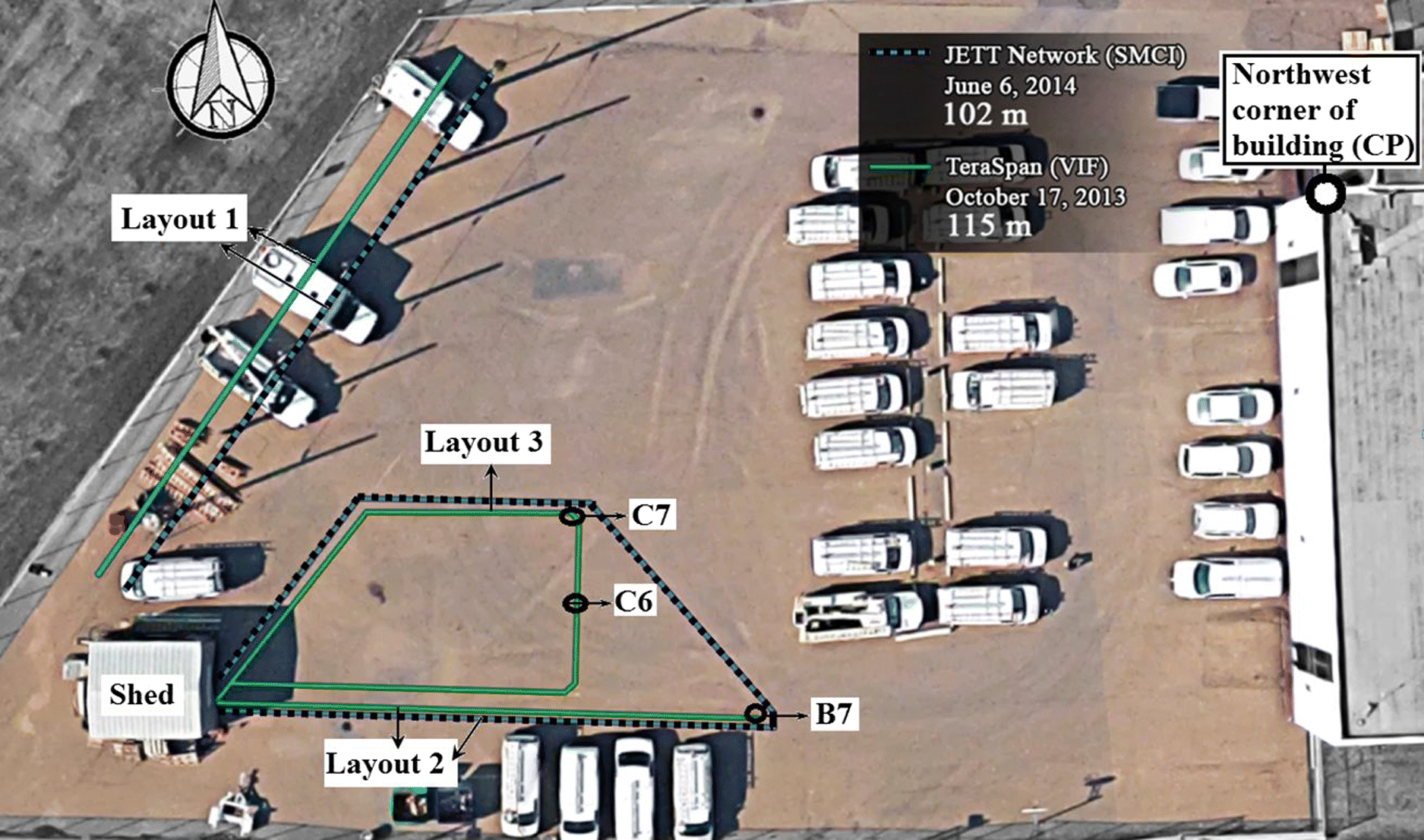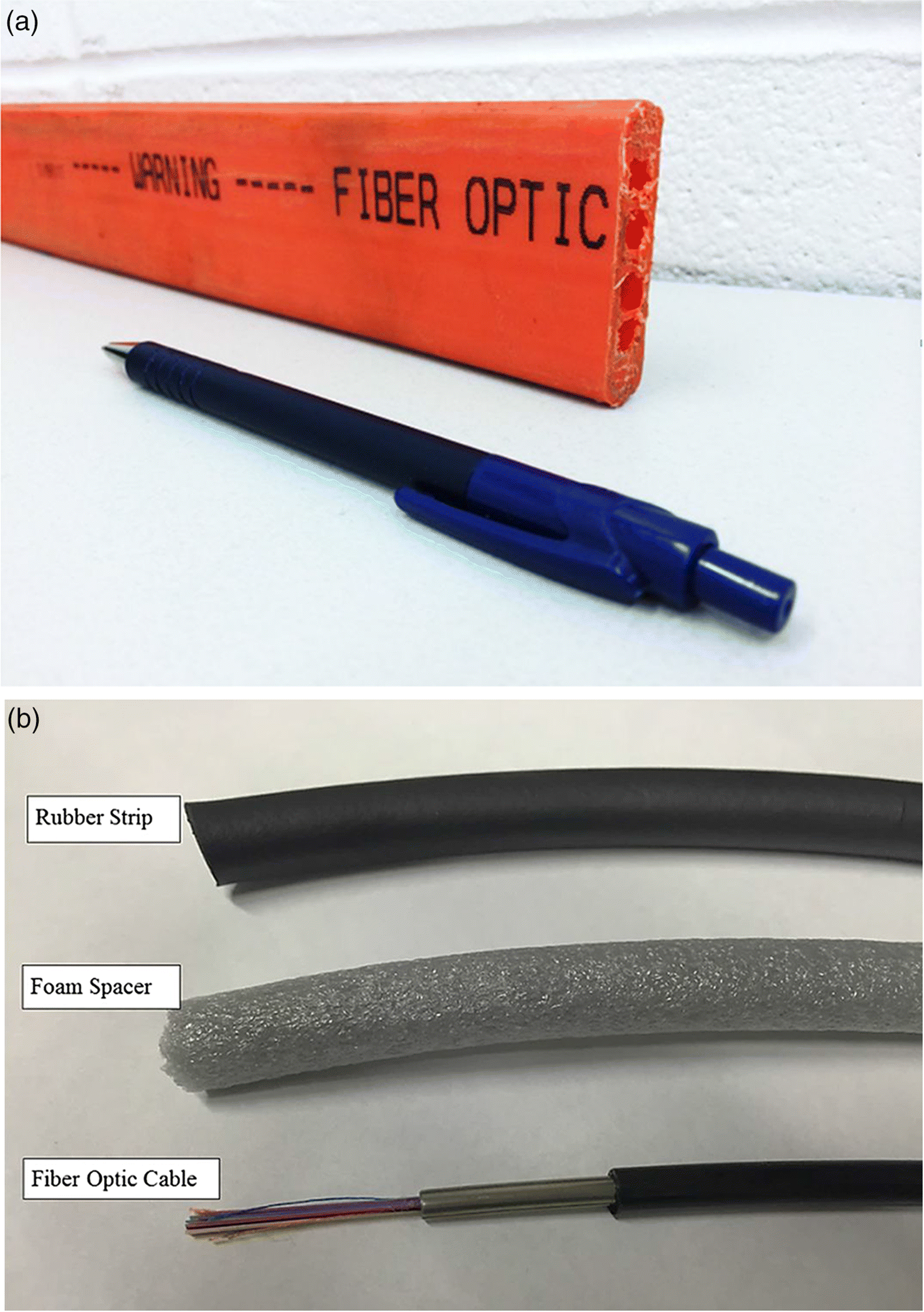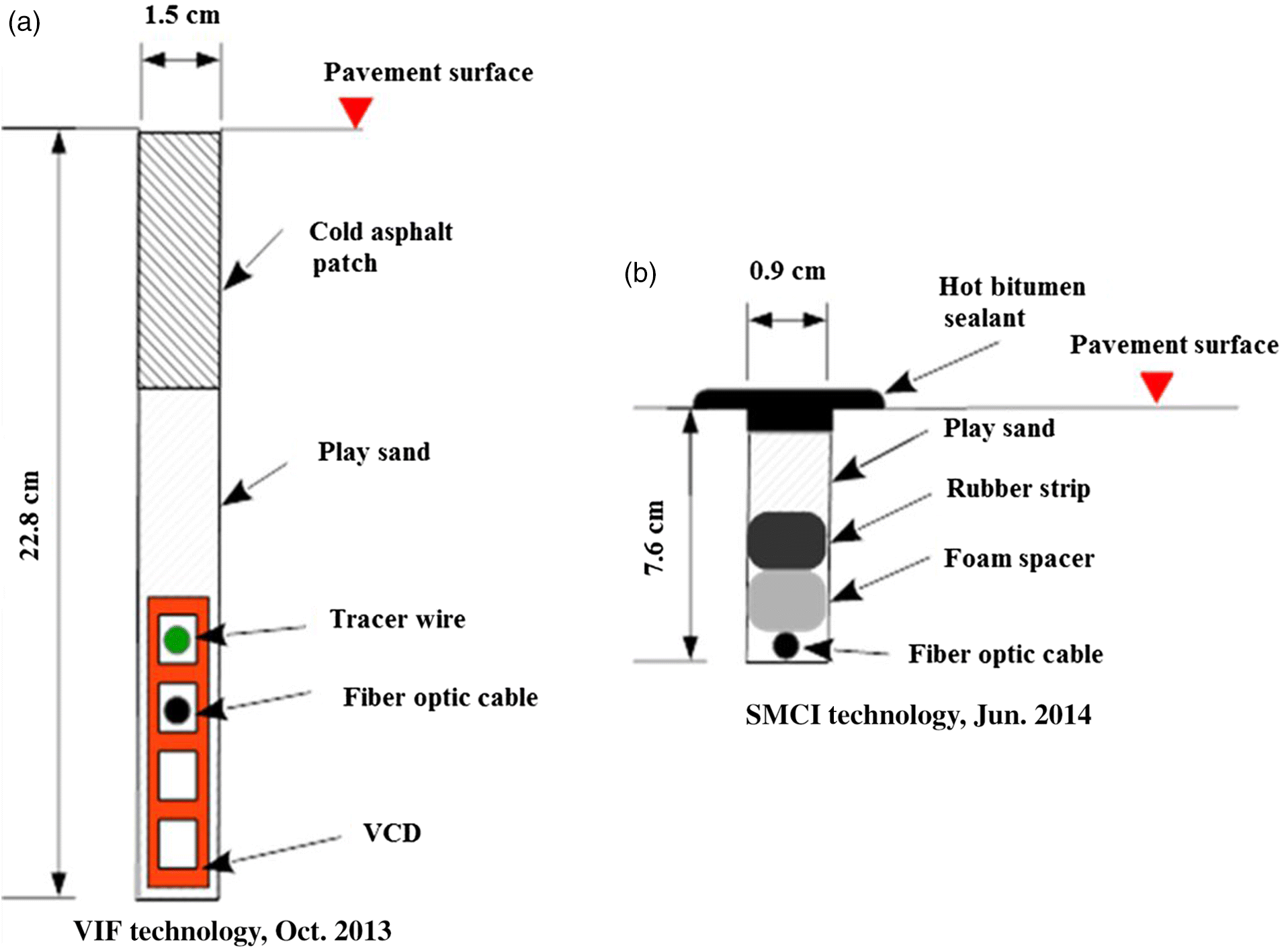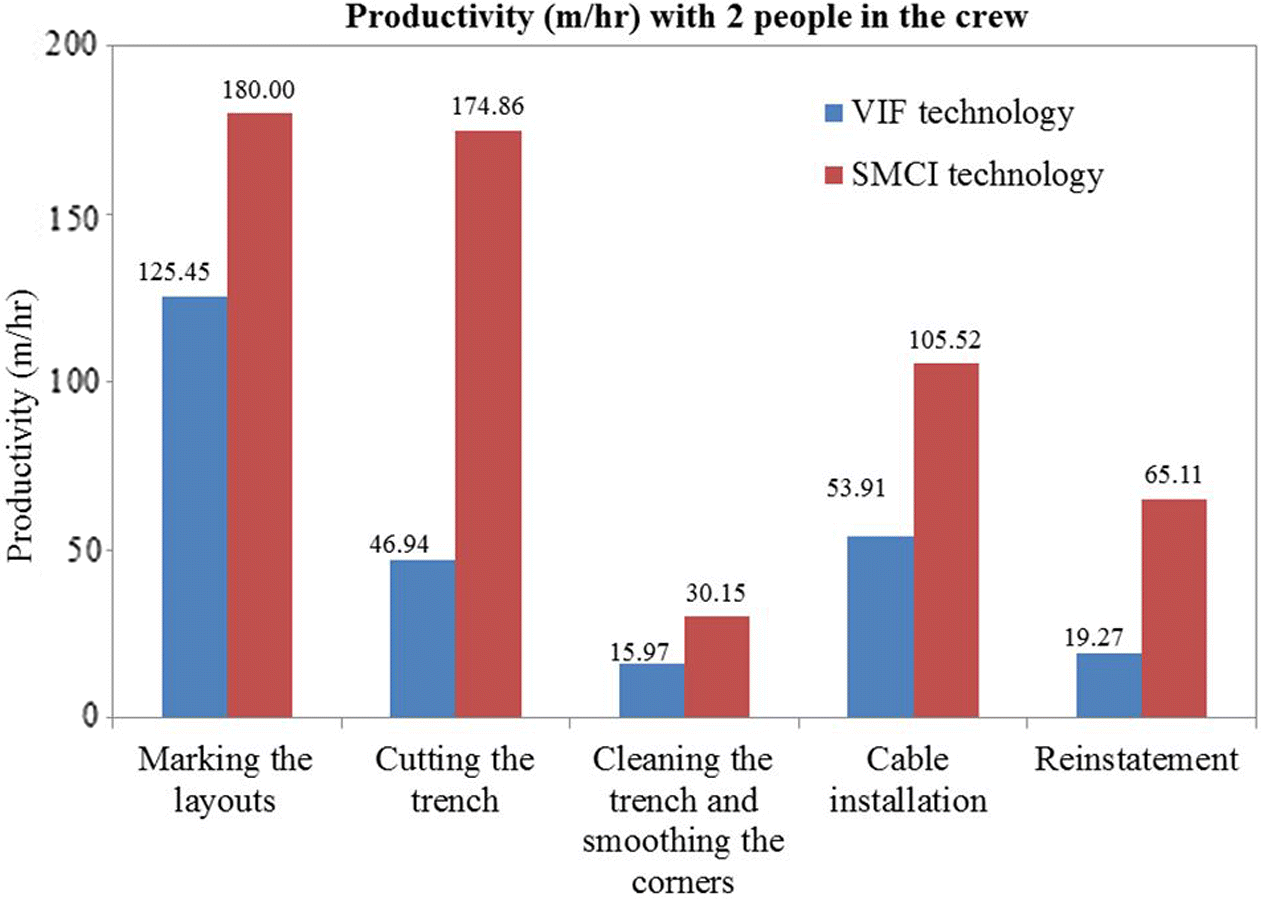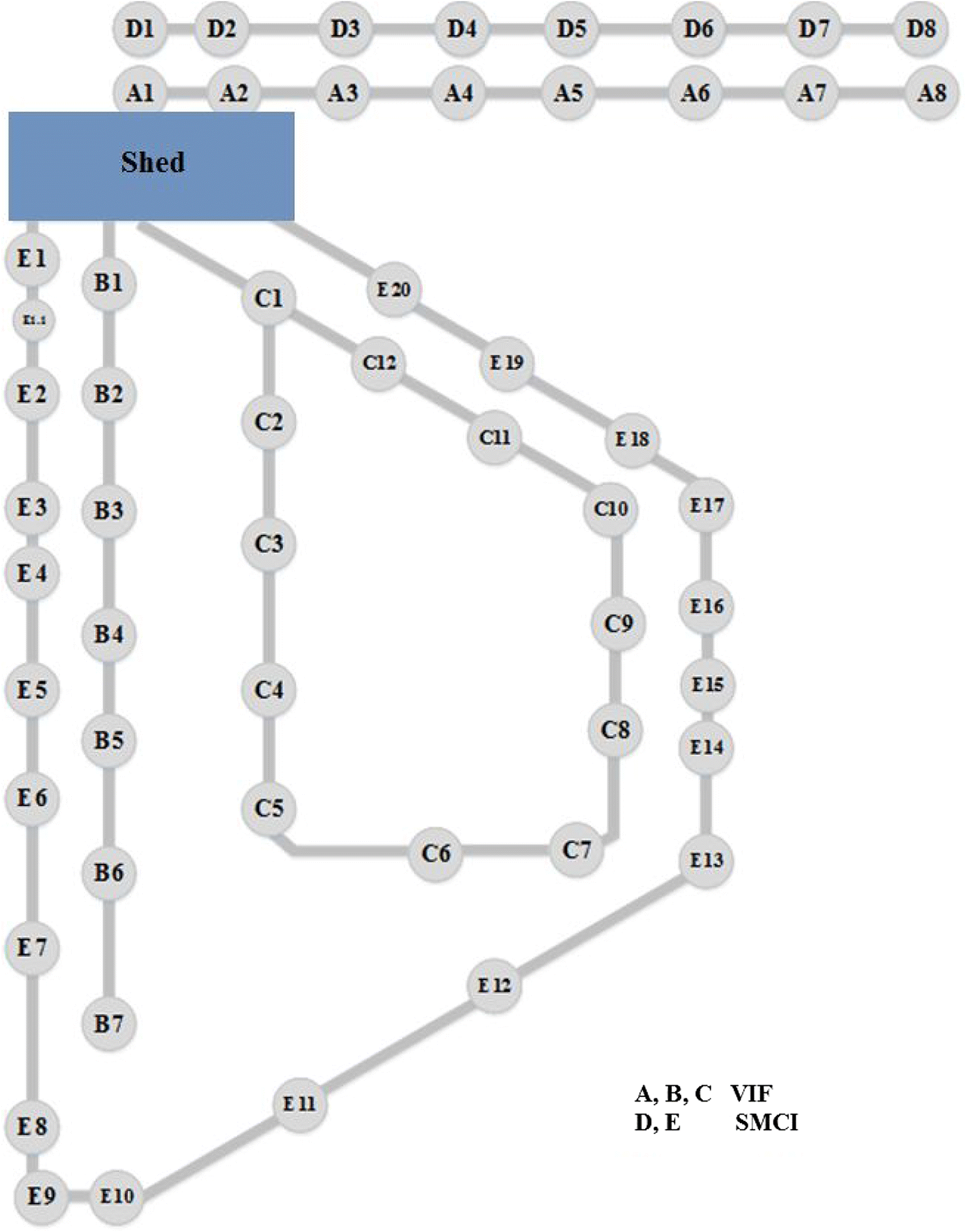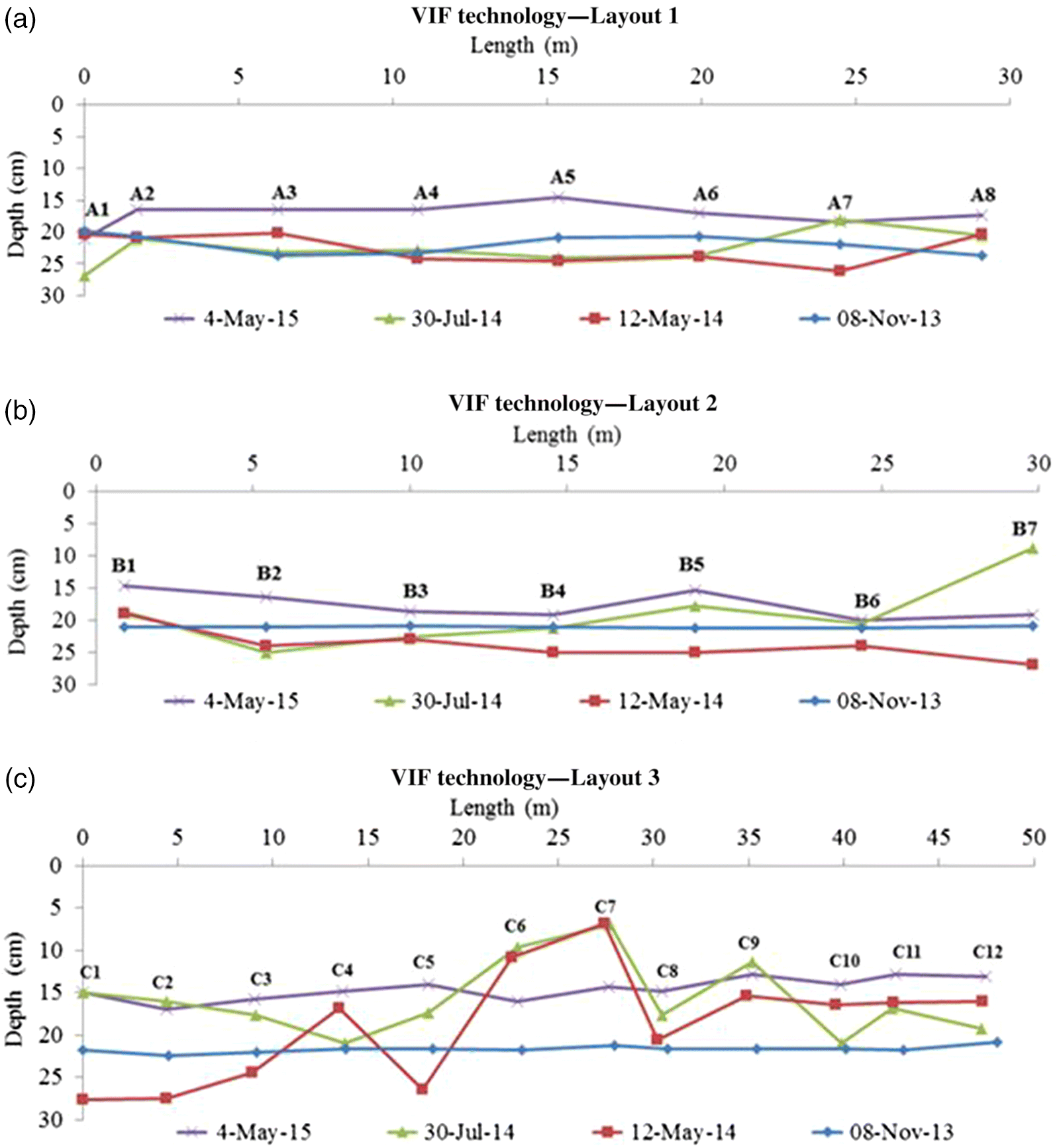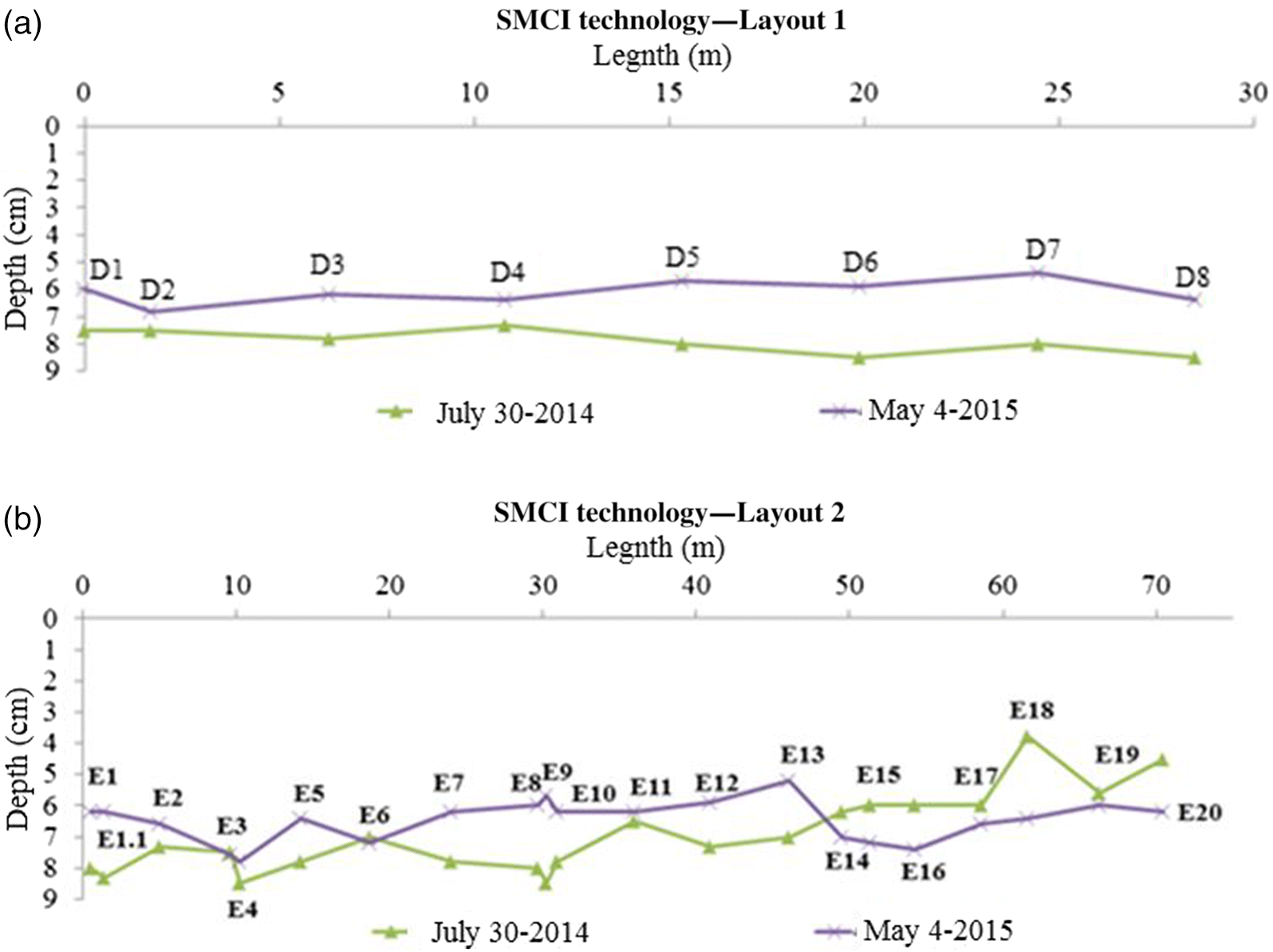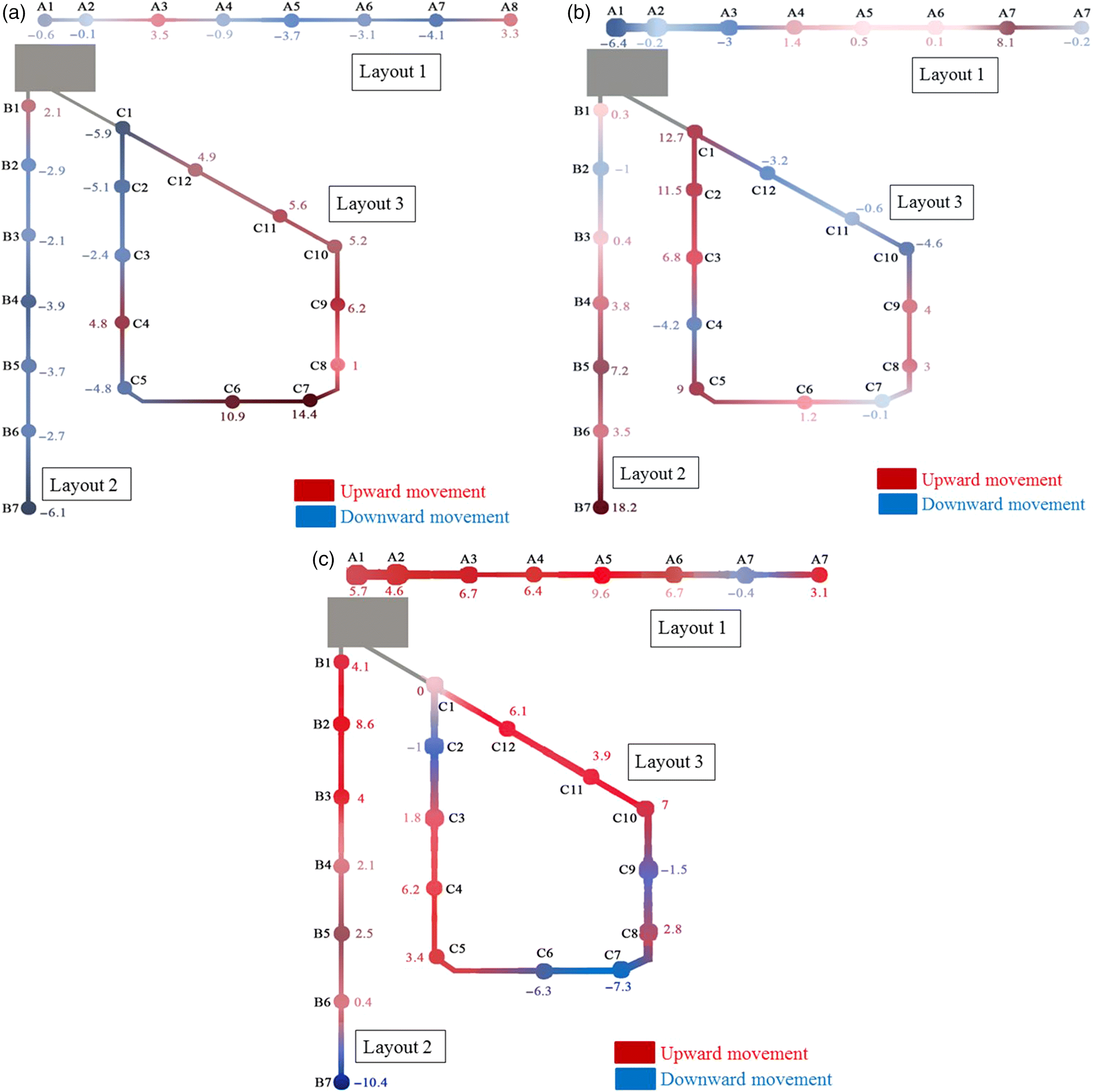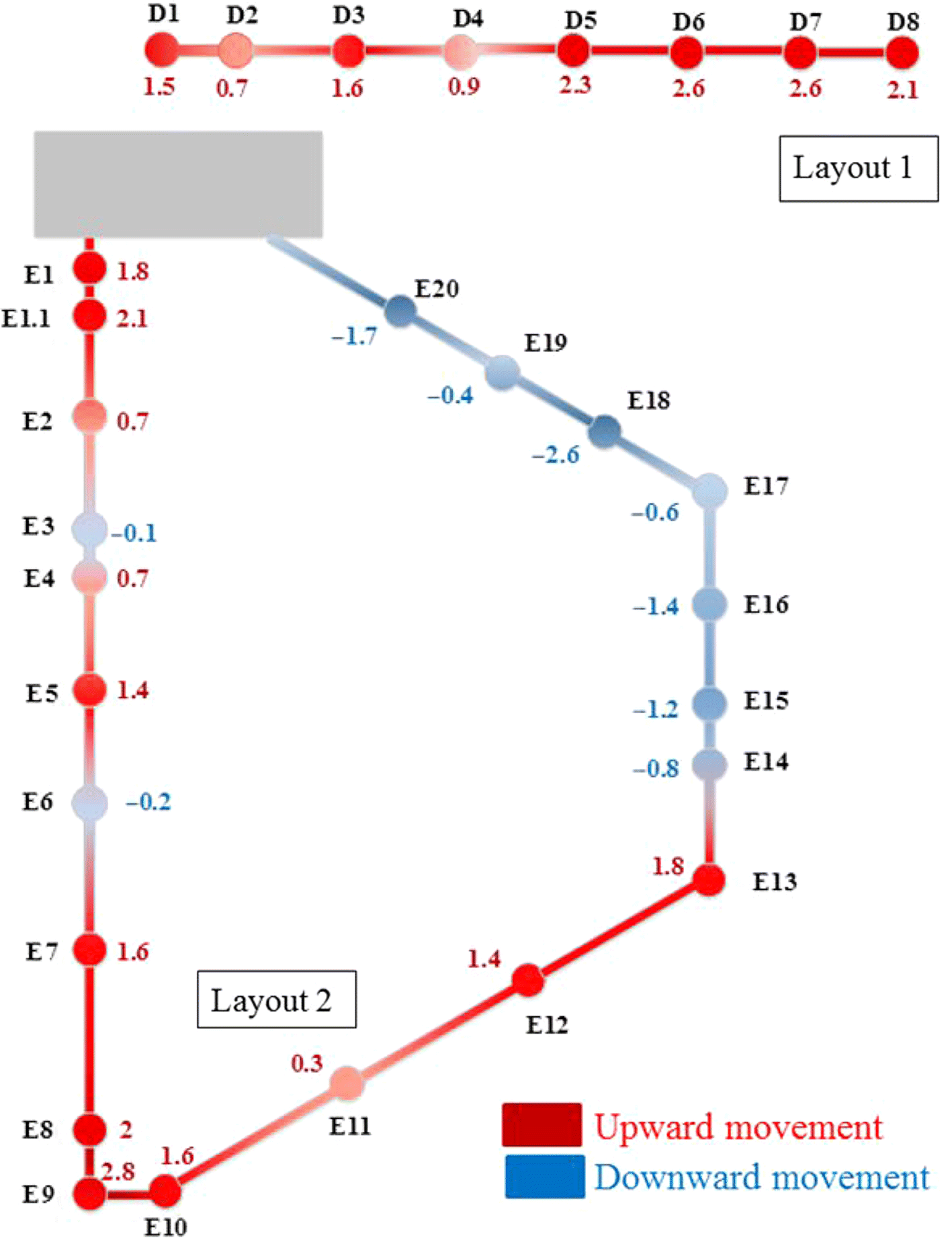To investigate performance and functionality of the installation technologies used in this study, GPR inspection and an OTDR test were performed.
GPR results
GPR is an electromagnetic, time-dependent technique that provides high-resolution images of shallow ground subsurfaces and can estimate the location and depth of buried objects. This equipment operates by scattering electromagnetic waves through material, which allows it to locate shallow underground objects via radio waves (
Daniels 2000;
Sensors & Software 2013).
The GPR system used was the Noggin250® made by Sensors & Software Inc. The unit operated at a frequency of 250 MHz, and both the transmitter and receiver were contained in a single unit. The unit incorporated an electronic encoder wheel and was connected to a real-time kinematic GPS system, allowing precise measurements of distances and locations. This unit was connected to a digital video logger (DVL) that captured and displayed the data, which could be viewed in real time and transferred to a laptop or PC.
In VIF technology, the tracer wire, inserted in the channels of VDC, is a copper-coated wire used to make the conduit more detectable by GPR when determining the location and its movement. To monitor the primary location of the conduit in the micro-trench after each installation, the first GPR inspections were conducted one month after the installations were completed. To investigate the effect of freeze/thaw cycles on the conduit movement, GPR inspections were continued after each winter.
Figure 5 shows the GPR-inspected points in both the VIF and SMCI installations on 8 November 2013, 12 May 2014, 30 July 2014, and 4 May 2015.
To investigate the physical integrity of the installation, conduit location was detected using GPR.
Figures 6a–
6c show the conduit profile of Layouts 1(A), 2(B), and 3(C) for VIF technology. It must be noted that the conduit profilewas obtained using its depth relative to the surface. In Layout 3(C), the loop is unfolded, and the conduit profile is provided. Points C5, C7, and C10 were located in the bends of the layout (the intersection of straight lines).
Figures 6a and
b show that both Layouts 1 and 2 were in relatively good condition with little vertical displacement toward the surface, except at point B7, which had a shallow depth of 8.8 cm according to the GPR inspection in July 2014. However, it moved downward and now has a depth of 19 cm according to a recent GPR inspection. In addition, in the northeast corner of Layout 3 (loop layout), the conduit depth was significantly shallower than its initial depth in July 2014. In
Fig. 6c, it can be seen that C7 and C6, with respective depths of 7 and 9.7 cm according to the GPR inspection in July 2014, were the shallowest points of the conduit profile in Layout 3 and had respective approximate displacements of 14 and 12 cm toward the surface. However, C6 and C7 moved downward and their current depths are 16 and 14 cm, respectively, according to recent GPR inspections. These three points (C6, C7, and B7) were in a more direct path of traffic compared with other points, as depicted in
Fig. 1.
Recent GPR inspections demonstrated that although the three layouts showed no significantly shallow points, the installations have moved upward from their installed depth (November 2013). Layout 3(C) has an average depth of 14.55 cm (compared with 21.5 cm in November 2013); this value is 17.4 cm for Layout 1(A) and Layout 2(B) (compared with 21.5 cm in November 2013).
It can also be concluded that traffic load causes increased conduit movement in layouts with bends compared with strictly straight layouts. In loop layouts, the conduit had increased upward and downward movements, which may have been the result of stresses induced in the bent portions of the layout.
To validate movements measured with GPR, three specific points (C6, C7, and B7) were excavated, and the locations of the conduit were measured manually.
Table 3 shows the GPR measurements versus the observed depths in the excavated sections in July 2014. The observed depths matched the GPR results; this verified that GPR measurements were reliable and correct. The consistent, approximate 1.5 cm difference between the GPR results and the observed depths occurs because the GPR measures the depth of the wire tracer within the conduit channel, whereas the observed depth measures the depth of the top of the conduit.
Figures 7a and
b show the conduit profile of Layouts 1(D) and 2(E) for SMCI technology. It must be noted that the conduit profile was obtained using its depth relative to the surface. In Layout 2(E), the loop is unfolded, and the conduit profile is provided. Points E9, E10, E13, and E17 were located in the bends of the layout (the intersection of straight lines).
The GPR results indicated that there was minimal fluctuation in the upward and downward movements in these installations; however, the installations had an average upward movement toward the surface of 1.7 cm in the straight layout (D) and 0.44 cm in the loop layout (E). The low fluctuation suggests that using a rubber strip and foam spacer to stabilize the cable in the trench is a promising technique, but the installation needs to be inspected for several years to draw stronger conclusions about its effectiveness.
Figures 8a–
8c and
9 show the seasonal movement of the conduits for both the VIF and SMCI installations from November 2013 to May 2014 (winter), May 2014 to July 2014 (summer), and July 2014 to May 2015 (winter). Negative signs indicate downward movement of the conduits, whereas positive signs indicate upward movement, both of which were measured in centimeters.
In the VIF installations in winter 2014 (
Fig. 8a), Layouts 1(A) and 2(B) experienced downward movements of up to 6 cm, with the exception of points A3, A8, and B1. The straight section of the loop layout (C) experienced the same movement, with the exception of C4. Conversely, C10–C12 had upward movements of approximately 5 cm. In addition to A3, A8, B1, and C4, these points followed a different trend due to conduit rigidity. When a portion of the conduit rose toward the surface, the other sections sank to maintain conduit stability. In addition, the northeast corner of the loop layout (C6, C7, C8, and C9) had lifted significantly toward the surface.
In the summer of 2014 (
Fig. 8b), conduit in Layouts 1(A) and 2(B) moved toward the surface, most significantly at B7 with an upward movement of 18 cm; however, A1 and A3 in Layout 1 experienced downward movements of 6 and 3 cm, respectively. The straight section of Layout 3(C) experienced similar conditions, with an upward movement of 6–12 cm toward the surface at all points except C4. The conduit had little movement in C6 and C7 as maximum movement occurred in winter, and the asphalt layer impeded further upward movement. C10 through C12 and C4 moved downward in response to upward movement in other sections of the loop due to conduit rigidity and stability maintenance.
In winter 2015 (
Fig. 8c), Layouts 1(A) and 2(B) moved toward the surface up to 9.6 cm, except at point B7, which had a downward movement of 10 cm. In addition, in Layout 3(C), the conduit moved upward up to 7 cm, except at points C6 and C7, which had a downward movement of 6 and 7 cm, respectively. Points C6 and C7 had the shallowest depths according to the July 2014 GPR inspection.
In the SMCI installation in winter 2015 (
Fig. 9), Layout 1(D) and the straight section of Layout 2(E) moved toward the surface up to 2.8 cm. However, the other section of the loop Layout 2(E) had a slight downward movement up to 2.6 cm.
According to
TeraSpan (2013), the shallow depth observed at the selected points is an installation-related issue. Specifically, certain points may not have been excavated as deeply due to obstacles within the ground or hard ground surface conditions. As a result, the conduit could not be placed deeply enough, and compression on either side of the spot creates potential for upward movement. The only solution for this issue is to ensure that the trench is clean and the depth is consistent along the installation length (TeraSpan, personal communication, 2014).
The quality of the micro-trench’s reinstatement plays an important role in preventing vertical movement of the cable or conduit. Based on the research results from the VIF installation, using sand and cold asphalt above the installed conduit is not a viable solution for trench reinstatement in cold regions. The material used in this step must flow easily inside the trench and stabilize the conduit in its place, thereby preventing future vertical displacement. Additional research is suggested to focus on reinstatement modification toward better stabilizing the conduit in the trench and, ultimately, preserving road strength.
